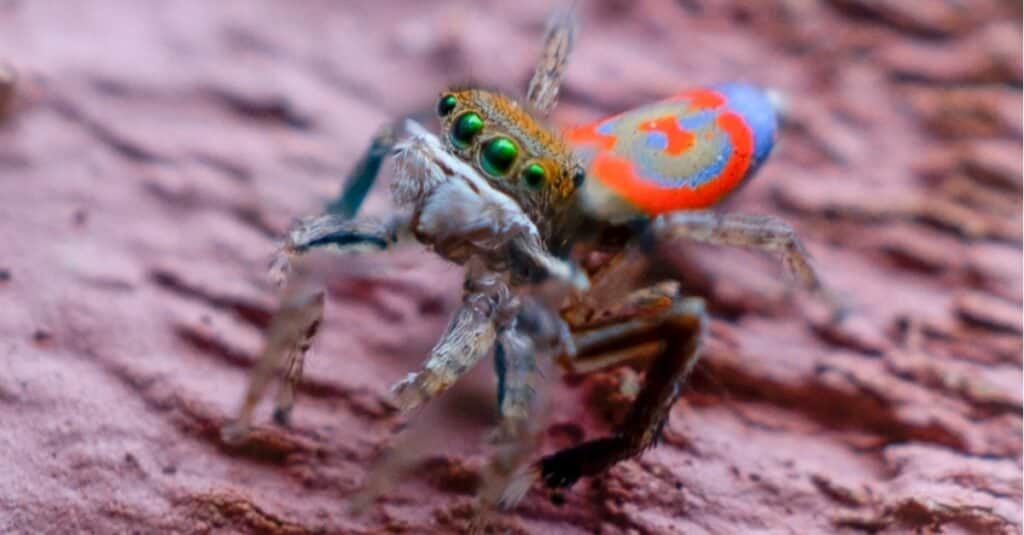Peacock Spider
.jumbotron {
background-image: url(“https://a-z-animals.com/media/2021/10/Peacock-spider-header-400×300.jpg”);
}
}
@media only screen and (min-width: 641px) and (max-width: 920px) {
.jumbotron {
background-image: url(“https://a-z-animals.com/media/2021/10/Peacock-spider-header-470×370.jpg”);
}
}
@media only screen and (min-width: 921px) {
.jumbotron {
background-image: url(“https://a-z-animals.com/media/2021/10/Peacock-spider-header.jpg”);
}
}
Peacock Spider
They can jump up to 10 centimeters (40 times their body size) and see the full rainbow spectrum of light, including UV.
Peacock Spider Scientific Classification
Read our Complete Guide to Classification of Animals.
Peacock Spider Conservation Status
Peacock Spider Facts
- Prey
- insects, spiders
- Name Of Young
- eggs
- Fun Fact
- They can jump up to 10 centimeters (40 times their body size) and see the full rainbow spectrum of light, including UV.
- Biggest Threat
- birds
- Most Distinctive Feature
- Brightly colored body
- Other Name(s)
- jumping spider, rainbow peacock
- Gestation Period
- 3-6 months
- Litter Size
- 100s of eggs
- Predators
- birds, reptiles, insects
- Diet
- Carnivore
- Type
- arachnid
- Common Name
- Peacock spider
- Location
- Australia
Peacock Spider Physical Characteristics
- Color
-
- Brown
- Yellow
- Red
- Blue
- White
- Green
- Orange
- Purple
- Lilac
- Skin Type
- Exoskeleton
- Lifespan
- ~1 year
- Length
- 4-5mm
- Age of Sexual Maturity
- 6-9 months
This post may contain affiliate links to our partners like Chewy, Amazon, and others. Purchasing through these helps us further the A-Z Animals mission to educate about the world’s species..

Spiders that fly! Fish that walk! And 1000+ more incredible animals. Discover them all for FREE
.photo-gallery {
–margin: 0px auto 0px;
–padding: 0px 0px 0px 0px;
}
.gallery-link {
background-image: url(“https://a-z-animals.com/media/2021/10/Peacock-spider-header-1024×535.jpg”);
background-repeat: no-repeat;
background-size: cover;
background-position: center;
height: 500px;
justify-content: center;
text-align: center;
align-items: center;
display: flex;
border: 2px solid #000;
}
.gallery-link img {
height: 50%;
}
@media only screen and (max-width: 768px) {
.gallery-link {
height: 300px !important;
}
}
View all of the Peacock Spider images!
Peacock spider refer to several species of Australian jumping spiders with elaborate mating dances.
They are not poisonous, only mildly venomous, and males are known for their brightly rainbow-colored bodies and ability to dance during their courtship rituals. They can jump about 10 centimeters, or 40 times as far as their bodies are long. They are not known to bite humans. They have a lifespan of approximately one year.
6 Incredible Peacock Spider Facts!
- Peacock spiders can jump as far as 40 times the length of their own bodies.
- Peacock spiders can see the entire light spectrum, including UV.
- Their intricate mating ritual includes dancing while manipulating their abdominal flaps.
- They come in a rainbow of colors.
- They get their name because the males are brightly colored and do a mating dance similar to that of a peacock .
- Females usually only mate once in their lifetime.
Peacock Spider: Species, Types, and Scientific name
There are 92 known species of Peacock spider, at present, seven of which were only discovered in 2020! The first one was discovered in 1878. This was Maratus karsch. In 2020, researcher Joseph Schubert found the Maratus azureus, Maratus constellatus, Maratus inaquous, Maratus laurenae, Maratus noggerup, Maratus suae, and Maratus volpei. Maratus volans is yet another species. 91 of the known Maratus species are Australian, but there is a single species, Maratus furvus, which is found in China.
Appearance: How To Identify Peacock Spider
Most Peacock spiders have a male which has a brightly colored abdomen, whose third legs are elongated and black. The abdomen on the males has a very flexible pedicel which is the narrow stalk which joins a spider’s abdomen to its cephalothorax, which is the term for the combined head and thorax of spiders, as it is fused in most if not all spiders. Both the longer third legs and the flexible abdomen are used during the mating dances. The colors found on the abdomen are also iridescent. In fact, some of the males are not brightly colored and only have the iridescence. The females are typically smaller and brown or gray.

iStock.com/sara carter
Habitat: Where to Find Peacock Spider
These unique spiders are found across the entire southern half of the Australian continent. They live across a wide range of habitats, and because of their hunting habits, many species roam over long distances and different regions. They can be found in grasslands, coastal dunes, scrub forests and desert areas, with some species being more specialized than others and living only on certain mountain tops or under the leaf debris of certain plants.
Diet: What Do Peacock Spider Eat?
Unlike most other spiders, Peacock spiders do not build webs. Their diets consist almost entirely of insects and other spiders. They have excellent vision, allowing them to easily locate prey, which they run after and jump on. They hunt during the day, unlike many other spider species. They can see all the colors of the rainbow spectrum, including ultraviolet light, which makes them excellent hunters. They are not picky eaters and will eat almost any insects or other spiders they can catch, sometimes even prey that is larger than they are. Occasionally, the females will eat the males.
View all 117 animals that start with P
Peacock Spider FAQs (Frequently Asked Questions)
Where does the peacock spider live?
Almost all Peacock spiders are found in Australia, except Maratus furvus, which is found in China.
What does a peacock spider eat?
These spiders are carnivores who prefer to eat insects, such as crickets.
Where can I buy a peacock spider?
While it may be possible to purchase them, it is not advised, as Peacock spiders have short lifespans and very specific habitats that would be hard to replicate in captivity.
What is a peacock spider?
A Peacock spider refers to a type of Australian jumping spider, the male of whom has colorful abdominal flaps with which he attracts a mate with a mating dance.
Is the peacock spider poisonous?
No, it is not poisonous. Like most spiders, the peacock is venomous, and uses its venom to bite its prey, but it is no threat to humans and does not bite them.
Are Jumping spiders the same as peacock spiders?
Peacock spiders are one type of jumping spider.
What year was the peacock spider found?
The first Peacock spider was discovered in 1878, but a researcher found seven new species in 2020.
Sources
- Slash Gear, Available here: https://www.slashgear.com/see-peacock-spider-joes-latest-discovery-of-7-new-species-30614878/
- Sierra Club, Available here: https://www.sierraclub.org/sierra/2013-4-july-august/critter/peacock-spider
- Wikipedia, Available here: https://en.wikipedia.org/wiki/Maratus_volans
- Evening Express, Available here: https://www.eveningexpress.co.uk/fp/news/viral/could-this-be-the-worlds-cutest-spider/
- Peacock Spider, Available here: https://www.peacockspider.org/where-can-i-buy-them-
- Peacock Spiders, Available here: https://www.cell.com/current-biology/pdf/S0960-9822(14)00591-0.pdf
- Thought Co, Available here: https://www.thoughtco.com/peacock-spider-4769343
- Peacock Spider, Available here: https://www.peacockspider.org/
















